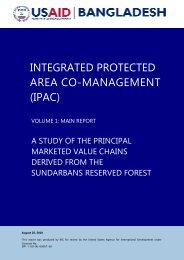Child Equity Atlas - BIDS
Child Equity Atlas - BIDS
Child Equity Atlas - BIDS
Create successful ePaper yourself
Turn your PDF publications into a flip-book with our unique Google optimized e-Paper software.
Literacy, School Attendance and Educational Attainment<br />
Table 3.5: Net attendance rate at secondary<br />
school: Best and worst districts,<br />
Bangladesh 2011<br />
Figure 3.10: Educational attainment (in %) of<br />
married and unmarried young women (15-24<br />
years), Bangladesh 2011<br />
Srl.<br />
Best districts<br />
Worst districts<br />
District % District %<br />
1. Jhalokati 69.6 Sunamganj 34.5<br />
2. Magura 66.4 Bandarban 36.8<br />
3.<br />
Joypurhat ,<br />
Panchagarh<br />
64.8 Cox’s Bazar 37.2<br />
4. Pirojpur 64.7 Habiganj 41.1<br />
5. Satkhira 64.6 Bhola 44.9<br />
Bangladesh: 54.3%<br />
3.9 Marital Status versus Educational<br />
Attainment of Female<br />
% of female (15-24 yrs.)<br />
35.0<br />
30.0<br />
25.0<br />
20.0<br />
15.0<br />
10.0<br />
5.0<br />
0.0<br />
16.7<br />
29.5<br />
Never to<br />
school &<br />
primary<br />
incomplete<br />
Unmarried<br />
29.2<br />
20.0<br />
Primary<br />
completed<br />
Level of<br />
Married<br />
31.5<br />
26.7<br />
Secondary<br />
incomplete<br />
on<br />
31.8<br />
14.6<br />
Secondary<br />
completed &<br />
more<br />
3.9.1 The educational attainment levels vary<br />
significantly between married and un-married<br />
young women aged 15-24 years. Overall,<br />
unmarried young women achieve higher levels<br />
of education as compared to married young<br />
women (Figure 3.10). While about one in three<br />
unmarried young women are able to complete<br />
secondary and higher education, only one in<br />
seven married women are completing the same<br />
level of learning. This indicates the adverse<br />
consequence of marriage on educational<br />
outcome of young women in Bangladesh. There<br />
are extensive reports on the socioeconomic<br />
consequences of early marriage for girls and<br />
the economy, by UNICEF 14 , Save the <strong>Child</strong>ren 15<br />
and several others 16 , to stimulate change, yet it<br />
remains a slow changing social norm in many<br />
countries including Bangladesh. The value of<br />
promoting education as one of several means<br />
to delay age of marriage is demonstrated by this<br />
report (Figure 3.10).<br />
14<br />
UNICEF 2004, Early Marriage: A Harmful Traditional<br />
Practice – A Statistical Exploration. http://www.unicef.org/<br />
publications/files/Early_Marriage_12.lo.pdf<br />
15<br />
http://www.savethechildren.org/site/c.8rKLIXMGIpI4E/<br />
b.6150521/k.1450/Bangladesh.htm<br />
16<br />
ICRW, 2007, How to End <strong>Child</strong> Marriage: Action Strategies<br />
for Prevention and Protection. http://www.icrw.org/files/<br />
publications/How-to-End-<strong>Child</strong>-Marriage-Action-Strategiesfor-Prevention-and-Protection-Brief.pdf<br />
Photo : UNICEF /Haque<br />
51














